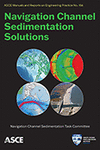Chapter 1
Introduction
Publication: Navigation Channel Sedimentation Solutions
Abstract
This chapter describes navigation channel sedimentation, lists solutions to sedimentation problems in those channels, and recommends best practices for predicting navigation channel sedimentation responses – sediment deposition to and erosion of the channel bed plus surrounding bed and banks – resulting from those solutions. Sedimentation embodies the processes of erosion, entrainment, transportation, deposition, and the compaction of sediment. These are natural processes that have been active throughout geological times and have shaped the present topographic and bathymetry dimensions of our earth. Navigation is a cost-effective way to transport many goods and can be less environmentally intrusive when compared to other transportation methods such as rail and trucks. Sedimentation issues may impact environmental quality through increased vessel emissions (caused by longer transit times or additional trips required by light-loading vessels) and impacts to ecologically important habitats and communities. The chapter also presents some of the key concepts discussed in this book.
Get full access to this article
View all available purchase options and get full access to this chapter.
References
Ariathurai, R. 1982. Two and three dimensional models for sediment transport. Lafayette, CA: Resource Management Associates.
Ariathurai, R., and R. B. Krone. 1976. “Finite element model for cohesive sediment transport.” J. Hydraul. Div. 102 (3): 323–338.
Burroughs, T. 2020. Navigation update: American Association of Port Authorities, AAPA virtual meeting. Washington, DC: US Army Corps of Engineers.
CTH (Committee on Tidal Hydraulics). 1971. Estuarine navigation projects. Tech. Bulletin No. 17. Vicksburg, MS: US Army Corps of Engineers.
Fatheree, B. H. 2004. The first 75 years: History of hydraulics engineering at the Waterways Experiment Station. Vicksburg, MS: US Army Engineer Research and Development Center.
Hamrick, J. M. 1996. User's manual for the environmental fluid dynamics computer code. Special Rep. in Applied Marine Science and Ocean Engineering (SRAMSOE), No. 331. Williamsburg, VA: College of William and Mary, Virginia Institute of Marine Science.
Hudson, R. A., F. A. Herrmann Jr., R. A. Sager, R. W. Whalin, et al. 1979. Coastal hydraulic models. Special Rep. 5. Vicksburg, MS: USACE, Coastal Engineering Research Center, Waterways Experiment Station.
Johnson, B. H., R. E. Heath, B. B. Hsieh, K. W. Kim, et al. 1991. User's guide for a three-dimensional numerical hydrodynamic, salinity, and temperature model of Chesapeake Bay. Tech. Rep. HL-91-20. Vicksburg, MS: USACE, Waterways Experiment Station.
Kruse, C. J., R. Farzaneh, B. Glover, J. E. Warner, et al. 2021. A modal comparison of domestic freight transportation effects on the general public: 2001–2019. Fayetteville, AR: University of Arkansas.
MARAD (Maritime Administration). 2021. Maritime transportation system (MTS). Washington, DC: US Department of Transportation.
Mehta, A. J. 2023. An introduction to hydraulics of fine sediment transport. 2nd ed. Singapore: World Scientific.
Mitchell, K. N. 2020. Quantifying impacts to shipping from vessel draft restrictions. Washington, DC: American Association of Port Authorities.
Roelvink, J. A., and G. K. F. M. Van Banning. 1995. “Design and development of DELFT3D and application to coastal morphodynamics.” Oceanogr. Lit. Rev. 11 (42): 925.
Rouse, H., and S. Ince. 1957. History of hydraulics. Iowa City, IA: Iowa Institute of Hydraulic Research, State University of Iowa.
Schulz, E. H. 1917. Vol. 9, The passes of the Mississippi river. Their description, physical characteristics, development, and commerce, 135–169. Professional Memoirs, Corps of Engineers, United States Army, and Engineer Dept. at Large. Alexandria, VA: Society of American Military Engineers.
Smith, T. P. 2019. USACE update for the American Association of Port Authorities. Washington, DC: US Army Corps of Engineers.
Teeter, A. M. 1989. Effects of Cooper River rediversion flows on shoaling conditions at Charleston Harbor, Charleston, South Carolina. TR HL-89-3. Vicksburg, MS: USACE, Waterways Experiment Station.
Thomas, W. A., and W. H. McAnally. 1985. User's manual for the generalized computer program system, open channel flow and sedimentation. TABS-2, IR HL-85-1. Vicksburg, MS: USACE, Waterways Experiment Station.
USACE (US Army Corps of Engineers). 1995. HEC-6 reservoir sediment control applications. TP-148. Davis, CA: USACE, Hydrologic Engineering Center.
USACE. 2017. Hopper dredge recapitalization analysis. Washington, DC: USACE.
USACE. 2021. Dredging Information. Washington, DC: USACE. https://publibrary.planusace.us/#/series/Dredging%20Information. Accessed December 3, 2021.
USACE. 2022. Final environmental impact statement for the proposed mid-Barataria sediment diversion project, Plaquemines Parish, Louisiana. New Orleans: USACE.
Vanoni, V. A. 1975. Sedimentation engineering. Reston, VA: ASCE.
Verified Market Research. 2022. “Dredging market size, share, trends, opportunities and forecast.” https://www.verifiedmarketresearch.com/product/dredging-market. Accessed March 22, 2022.
Information & Authors
Information
Published In
ISBN (Print): 978-0-7844-1616-7
ISBN (Online): 978-0-7844-8514-9
Copyright
© 2023 by the American Society of Civil Engineers.
History
Published online: Nov 3, 2023
Published in print: Nov 8, 2023
ASCE Technical Topics:
- Bed materials
- Channels (waterway)
- Entrainment
- Erosion
- Geology
- Geotechnical engineering
- Hydraulic engineering
- Hydraulic structures
- Infrastructure
- Navigation (waterway)
- Rail transportation
- River and stream beds
- River engineering
- Rivers and streams
- Sediment
- Transportation engineering
- Water and water resources
- Water transportation
- Waterways
Authors
Metrics & Citations
Metrics
Citations
Download citation
If you have the appropriate software installed, you can download article citation data to the citation manager of your choice. Simply select your manager software from the list below and click Download.
